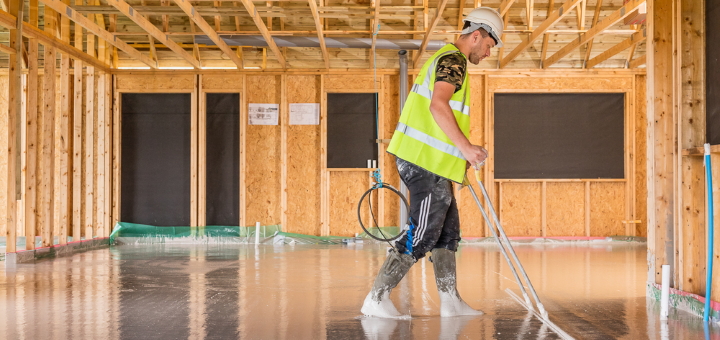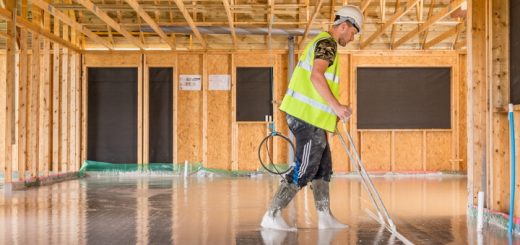Why every homeowner should consider underfloor heating

Heating is one of the most important costs that you have to take into consideration when owning a property of any size. There are more heating options now than ever, some more efficient than others. One option that is growing in popularity at the moment is underfloor heating.
The way underfloor heating works is simple. Warm water is sent through a circuit of pipes located under the finished floor. This creates radiant heat, which is different from the convection heat emitted by radiators. The water is pushed through the pipes using a heat pump.
Let’s take a closer look at why underfloor heating is such a great choice for homeowners.
Greater safety
Underfloor heating systems run at around 40 degrees Celsius. Furthermore, this heat seeps into the floor and is radiated up into the room. You don’t come into physical contact with the heating elements, so it’s perfectly safe.
In contrast, radiators run at 70 degrees Celsius, and your children or pets may come into physical contact with them. This creates a burn hazard. Another benefit of underfloor heating systems is that there are no floor or wall projections people could trip on or run into.
More space
Underfloor heating elements are entirely under the floor. You don’t have to give up a corner of the room for a radiator, along with ensuring there is a safe perimeter around it.
You’ll enjoy more space in every room in addition to removing the unsightly obstacle that radiators can be. Underfloor heating is completely invisible. You can make the most of the space, using every corner and wall for storage, seating, furniture and more.
Greater efficiency
Because underfloor heating systems are so much more efficient, they are a natural choice for homes with heat pumps. They radiate heat from the ground level, which rises up. This eliminates convection losses and draughts created by conventional radiators. You’re also heating up a floor that will retain the heat when the heating is turned off, thus keeping a room warm for longer.
Regular radiators work by heating the ambient air in the room. The air that is closer to the radiator will be the hottest. And hot air automatically rises to the top. This means that the floor is the last part of the room that gets heated.
Underfloor heating can also help you reduce your emissions and costs. You’ll be able to reduce up to one-third of your fuel costs and carbon dioxide emissions compared to conventional wall-mounted radiators. That means you can heat your entire home with heat pumps – aside from the fact that heat pumps are three times as efficient as boilers.
Note that you don’t have to pay for new floors to get underfloor heating systems installed. Providers like Incognito Heat Co can install an underfloor heating system under your existing floors – or install new floors if that’s what you want – as they have been fitting underfloor heating in Newcastle for years.
Service providers like these can install both heat pumps and underfloor heating systems – so you can call them when you decide to replace that ageing boiler, or when you realise you want new heated floors after the old floors were ripped out during your home’s renovation. Either way, you’ll save money on energy costs with minimal inconvenience.
Improved comfort
The typical radiator tends to sit under a window. That area may be warm, but the room gets progressively cooler as you move away from the radiator. With underfloor heating, the entire room is the same temperature.
Furthermore, underfloor heating systems eliminate draughts in your home. You don’t have to open a window to let in fresh air to compensate for the recirculated air from the radiator. The end result is much more comfortable, because the room is the same temperature throughout. And if you do open a window to let in fresh air or open the vents in your duct system, you’ll lose less energy than if the space was heated by radiators.
A side benefit of underfloor heating systems is how quickly they work. They can heat up an entire room in less than twenty minutes. This may be the incentive you need to turn down the thermostat when you’re at work, because it won’t take an hour or more to warm up ice-cold rooms.
Greater temperature control
Traditional radiators need the water to be at 66 degrees Celsius in order to warm up a room. You almost have to have a hot spot in the room to warm up the rest of the room, even if you want the space to be at 20 degrees.
In contrast, underfloor heating systems have a recommended temperature of 28 degrees. That gives you a pleasant environment without generating excess heat that’s either uncomfortable or needs to be carefully distributed throughout the room via fans. The heat from the flooring system will slowly radiate up towards the ceiling, but you aren’t wasting energy heating the air at ceiling level and hoping it circulates.
Simpler maintenance
Underfloor heating systems are a once-and-done project. You don’t have to do maintenance on such systems, whereas traditional radiators do require periodic checks and repairs. Nor do underfloor heating systems ever require expensive revisions. Another point in favour is that you can get a comprehensive control package as part of the installation cost.
The ability to live off the grid
Heat pumps are much more energy-efficient than traditional home heating systems, and underfloor heating systems use less energy than conventional radiators. This combination allows you to enjoy a warm home powered by renewable energy, whether you’re running off generators or solar panels.
You can also combine underfloor heating systems with geothermal energy systems like ground-source heat pumps. Furthermore, this combination can dramatically lower fuel bills in areas without access to mains gas. It allows you to heat your home without having an insanely high electric bill.
That is why these systems may qualify for a renewable heat incentive (RHI) that can offset the installation costs. This is true whether you use an air-source or ground-source heat pump. Air-source systems are much more efficient than boilers, though they aren’t as efficient as ground-source or ground-loop heat pumps.
How to choose the right heat pump
Now that you know some of the benefits of underfloor heating, you have to know how to choose the right heat pump to go with it. Choosing a heat pump can be difficult. You should take factors like initial cost, operating costs, efficiency and comfort into account. You also need to consider the distribution systems you’re going to have in your home, whether it is radiators or underfloor heating (UFH).
There are two principal types of heat pumps: air-to-water and water-to-water heat pumps. Each of them has significant differences, and they also have their own pros and cons.
The biggest difference between these two types of heat pumps is the method they use to harvest heat. Water-to-water systems gather heat directly from the ground by using geothermal ground loops. The loops comprise of plastic piping with an antifreeze solution circulating inside. The solution then collects low-grade heat right from the ground and recirculates it through your underfloor heating system.
This means that the pumps require a lot more work to install. They will either require vertical borehole drilling or excavation, which will cost extra. On the other hand, air-to-water systems extract heat from outside air, not from the ground. The air is collected using a unit that is installed on a concrete slab outside the home. This means no drilling and no complex loop system, which translates to lower costs for installation. But it doesn’t stop there.
While air-to-water systems are much less complicated to install than water-to-water systems, they are also much less efficient. This is especially true during the winter months when the system has to exert even more energy to heat the water. Not only that, but geothermal systems last a lot longer as well. All the major components are either deep inside the ground or in a controlled environment inside the house. As a matter of fact, water-to-water systems can last up to 20 years when properly maintained.
So, it’s essential that you look further than the installation cost when picking a unit and consider the long-term savings as well.
Conclusion
These are just some of the reasons why you should consider installing a heat pump and underfloor heating system. Underfloor heating could help you save energy, money, and the environment, all while enjoying a more comfortable home.
So, make sure that you look closely into it, and work with a team that will be able to guide you through the options and help you find the best setup for you and your home.










1 Response
[…] The obvious starting point is furniture; when arranging furniture you need to keep in mind window and door placement. In converted garages especially, it is not recommended that you put the bed along an outside wall unless the wall has been properly insulated. It is undoubtedly important that your bedroom is warm, so if heating is an issue it might be an idea to consider placing underfloor heating. […]